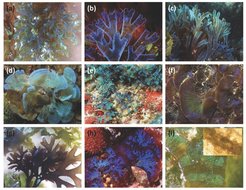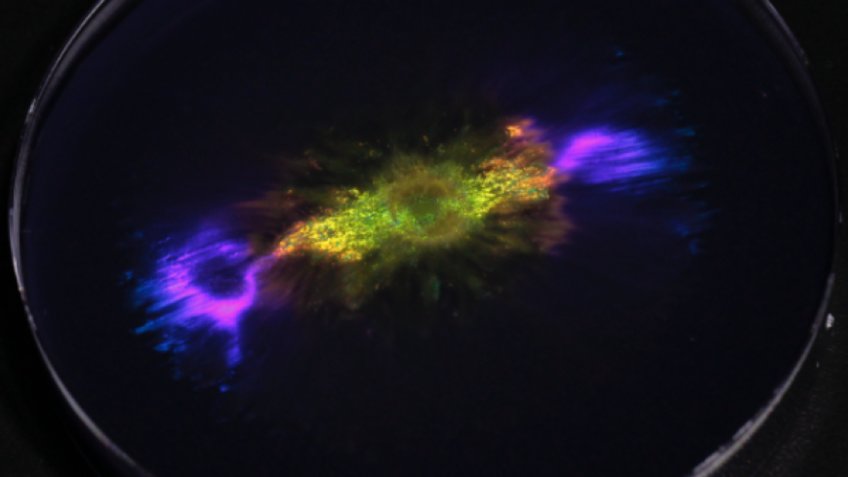
Structural Colour in Nature
Structural Colour in Bacteria
Nature’s structural colouration has garnered significant attention due to its ability to produce vivid, iridescent hues without the use of pigments. This phenomenon arises from the interaction of light with nanostructures within the organisms, leading to the selective reflection of specific visible wavelengths. While extensively studied in eukaryotic organisms such as butterflies, birds, and marine creatures, structural colouration in prokaryotes has remained largely unexplored, despite accessible genetics largely lacking for eukaryotic structural colour. We focus on a type of marine bacterium Flavobacterium Iridescent 1 (IR1), which forms colonies with striking iridescent colours. These colours are attributed to the highly ordered, three-dimensional arrangement of the rod-shaped bacterial cells within the colony, which acts as a living photonic crystal. The periodic structure, with a lattice constant on the order of the wavelength of visible light, gives rise to the angle-dependant, shimmering hues.
Our interdisciplinary research aims to bring together inspirations from nature with microbiology, biophysics, optics, and materials science. Through a combination of advanced optical characterisation techniques, genetic engineering, and innovative fabrication methods, we seek to unravel the mechanisms underlying the self-organisation of structural colour forming bacteria and their optical properties, as well as developing a new class of bio-derived photonic materials with applications ranging from sustainable pigments to adaptive coatings and sensors.
Our research covers mainly the following topics:
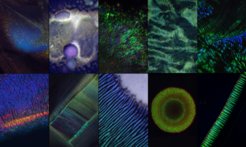

- Structural colour formation mechanisms in microorganisms. We develop multiscale characterisation methods to investigate rich phenomena observed at individual bacterium and colony length scale. Combining correlative microscopy techniques such as goniospectrophotometry, microspectroscopy, confocal microscopy, quantitative phase imaging, and tomography methods, we aim to elucidate the relationship between microscopic bacterial organisation and macroscopic optical properties.
- Self-organisation of Flavobacterium in Confinement. We explore structure formation and dynamics of bacterial collective activities in various geometries, from 2D surface to 3D confinements. Collaborating with microbiologists, bioinformaticians and theoreticians, we investigate the interplay between bacteria motility, cell-cell interactions, and geometric constraints to regulate bacteria colonies into desirable nanostructures and optical properties.
- Bacteria-Based Sustainable and Living Materials. Building upon the above-mentioned fundamental insights, we leverage cutting-edge fabrication methods such as 3D bioprinting and complex emulsions to translate structural colour bacterial colonies into sustainable optical materials. These include permanent bacteria-based colour films, photonic pigments. Additionally, we develop living materials that exhibit programmable growth, autonomous adaptation, and regeneration.
Structural Color in Animals

Structural colour can be found across kingdoms, from single celled organisms to plants and a variety of animals. Although known to be some of the most flamboyant animals in the marine environment, there have been few studies on the structural origins of colouration in sea slugs. In the SBM group we are studying a range of sea slugs from across different clades, in order to elucidate the various photonic structures used by sea slugs to generate colour. Specifically, we are using electron and optical microscopy to image novel photonic structures in different species, and understand how they are able to generate specific and brilliant colours from these structures. In addition to uncovering novel photonic architectures, we are also interested in the biogenesis, and functional significance of the colour. To do this we are imaging the colour during its formation and mapping different material pathways inside the bodies of the animals using a range of tomographic techniques and confocal microscopy. Sea slugs are unique in the field of animal colouration because they are habitual thieves, stealing chloroplasts or noxious chemicals from their prey. We are particularly interested in how structural colouration may have evolved concurrently with these processes.
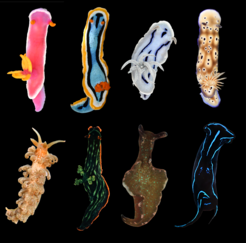
Structural Colour in Plants
Colour in nature serves a wide range of purposes. In plants, it plays a role in optimising light absorption for photosynthesis, providing photoprotection, or communicating with animals—either to attract or repel them. The function of colour, as well as the method by which it is produced, can differ not only between species but also within various parts of the same plant. Due to the diverse roles that colour serves in plants, there is also a broad array of mechanisms developed to generate it, each suited to its particular function. In the Sustainable and bio-inspired materials department, we study the occurrence of structural colouration in a variety of plants. Our research focuses on analysing the properties of these photonic structures and exploring their evolutionary development throughout the plant kingdom.
In flowers, colour is often used to draw in pollinators. Some species achieve vibrant colours by growing striated structures on their petals, which act as diffraction gratings, reflecting short-wavelength light such as blue or ultraviolet (UV). A notable example of this can be seen in the petals of Grielum humifusum, which reflect UV light to attract bees (Moyroud et al., 2017). This phenomenon has been observed in many flowers across different taxa, suggesting that these ridged structures have evolved independently in various lineages of flowering plants (Moyroud et al., 2017).

Leaves produce colour for entirely different reasons compared to flowers. They frequently rely on photonic structures for photoprotection. Short-wavelength light, such as UV and blue light, can be damaging to the photosynthetic tissues in leaves. Many plants that thrive in shaded environments are not well-equipped to tolerate direct sunlight. However, even in relatively shaded habitats, they can sometimes be exposed to intense light. For instance, plants growing in the forest understory are adapted to low light conditions, but sunlight occasionally penetrates through the canopy. To cope with this, such plants have developed mechanisms to reflect short-wavelength light. Plants like Microsorum thailandicum form helicoidal multilayer structures that reflect light in the UV and blue spectrum (Steiner et al., 2018).
In contrast to leaves that use photoprotective structures to reflect short-wavelength light—often resulting in a blue appearance—leaves from Tradescantia pallida exhibit a golden sheen. This long-wavelength reflection is caused by a disordered arrangement of wax platelets on the leaves, although the function of this structure is still unclear (van de Kerkhof et al., 2020).
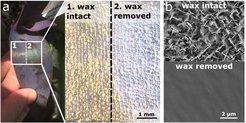
Above, we have highlighted our research on structural colour in flowers and leaves. However, our investigations extend throughout the plant kingdom. For instance, we study the appearance and evolution of structural colour in fruits of land plants and explore photonic structures in algae (Chandler et al., 2015).
Structural Colour in Fruits
Structural colour is also widespread in fruits, where one-dimensional periodic reflectors cause a bright colouration. For instance, the metallic appearance of Pollia (Vignolini et al., 2012) and Margaritaria (Vignolini et al., 2016) is produced by the helicoidal arrangement of cellulose fibres in the cell wall: the periodicity is such that blue and green hues are reflected from each cell, giving the fruit a ‘pointillistic’ structural colouration.
Other fruits, including Viburnum (Middleton et al., 2020) and Lantana (Sinnott-Armstrong et al., 2022), build a multilayer reflector in their cuticle using lipids. The reflected UV and blue colours serve a communicative purpose: the colouration signals a high nutritional reward, attracting animals for seed dispersal. On the contrary, fruits like Pollia lack in nutritional content and mimic the colouration of other fruits to attract herbivores. For this reason, they are called ‘deceitful’ structurally coloured fruits.
In addition to analysing the optical properties of photonic structures in plants and fruits, we also focus on determining their chemical composition. Structures found in cell walls, such as those in Microsorum, are typically composed of cellulose, but other plants may exhibit varying compositions. By combining chemical extraction methods with imaging techniques, we can elucidate the chemical makeup of these observed photonic structures (Middleton et al., 2020).
Structural Colour in Algae
After a few decades, structural colour in land plants is now more understood and interdisciplinary. On the other hand, there is still a deep lack of knowledge on photonic structures in marine algae. Although the observation of some iridescent seaweeds has been reported since the 19th century, the phenomenon has been treated only as a taxonomic character for decades. So far, photonic structures are reported in diatoms (a group of microalgae), and brown and red seaweeds (Chandler et al., 2017). In seaweeds, structural colour arises from both intra- and extracellular structures. For instance, certain brown and red algae possess intracellular vesicles containing highly ordered three-dimensional structures. Given their characteristic shape and angle-dependant optical appearance, they are historically called ‘iridescent bodies’. However, despite being documented across multiple orders in both brown and red algae, little is known about their function. Similarly, certain red algae such as Chondrus crispus possess a multilayered cuticle that reflects selectively UV and blue hues, possibly conferring photoprotection to the inner organelles (Chandler et al., 2015; Fleitas et al., 2024).
In our group, we aim to understand how widespread this phenomenon is among different orders and algal groups, and what is its role for the light management in the organism. As for other structurally coloured organisms, different microscopy techniques are central for the investigation of these structures, from light to electron microscopy.
